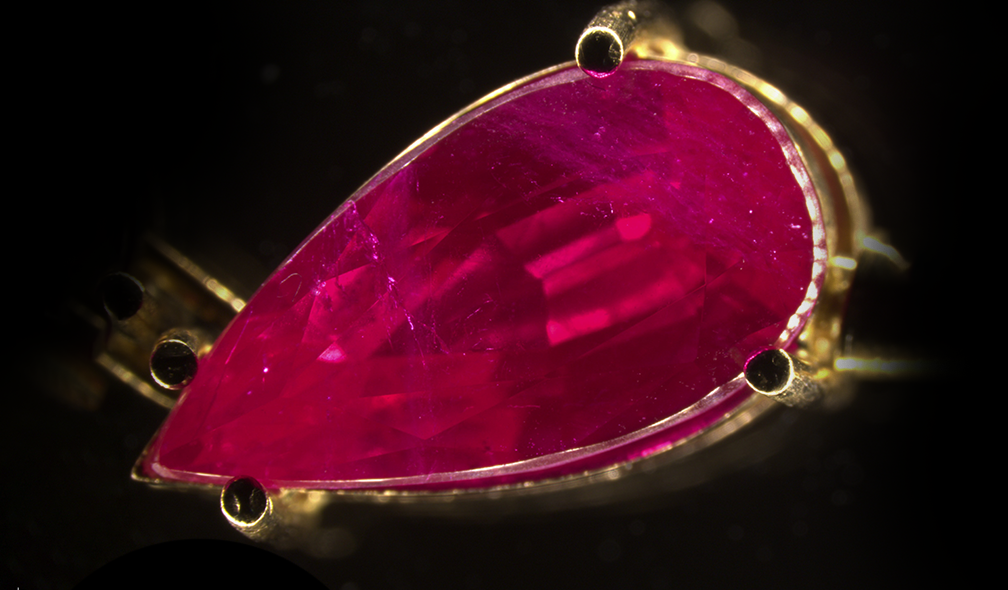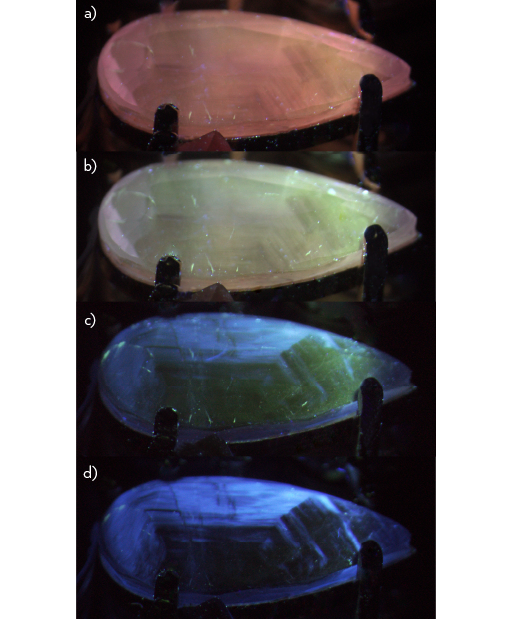
The unusual case of a jewel with a large number of flux-grown synthetic rubies sold as natural rubies
A necklace with rather important sizeable rubies was submitted to GGTL Laboratories Liechtenstein with the request to identify treatments and country of origin. The piece was mounted with ≈ 50 stones of high quality and very attractive and saturated red colour; the stones were somewhat included and showed mainly fingerprints and clouds amongst other small and atypical inclusions (Fig 1).

Fig. 1. and cover image. Two of the flux grown synthetic rubies exhibiting rather atypical fingerprint and cloud-like inclusions. Micrographs T. Hainschwang.
At first glance under the microscope, we noted that most of the stones resembled to what one would normally call heat treated with some glassy residues, but that none of the inclusion scenarios gave away any possible country of origin, something highly unusual when an experienced analyst observes such stones. This fact led immediately to the suspicion that the rubies were flux-grown synthetics; to confirm this the stones were more closely inspected by microscopy, followed by infrared spectroscopy, chemical analysis and finally DFI fluorescence imaging and spectroscopy. Chemical analysis of the stones showed that they were all lacking gallium and vanadium and that they main chemical characteristics were high chromium content and low to moderate iron content. This by itself was practically proof that the rubies were indeed flux synthetic rubies, and not natural as believed by the client. A closer look at the inclusions allowed us to identify some features besides glassy residues and clouds that clearly pointed towards flux-grown synthetic rubies; these include some tiny metallic inclusions including some platinum needles and hexagonal platinum platelets (residues from the growth crucible) and a few unusual multi-phase inclusions made of flux and gas bubbles.
A series of inclusion pictures of the stones is shown below: a) to j) various forms of residues from the flux used for the crystal growth; k) to n) platinum inclusions (needles and platelets); o) to p) dust-like stringers, “comets” and clouds that appear blue from Tyndall scattering; q) large multi-phase inclusion consisting of flux and gas bubbles.

Figure 2, a to q. A selection of inclusion micrographs representing some of the features found in the flux synthetic rubies. Micrographs T. Hainschwang.
Properly filtered fluorescence imaging of the synthetic rubies performed with the Mega-DFI prototype fluorescence imaging and spectroscopy instrument revealed the characteristic fluorescence properties seen for many flux-grown sapphires and rubies. This may – if not carefully analysed – be mistaken as the fluorescence of heat-treated corundum: all samples exhibited chalky blue fluorescence under excitations <300 nm and under other specific excitations in the shorter wavelength range, a green fluorescence was visible, often in distinct sectors (Fig. 3). The green fluorescence identifies such rubies unambiguously as flux-grown synthetic as it has not been observed in any other corundum, natural or synthetic (id est flame-fusion, Czochralski or hydrothermal). This type of fluorescence can be very dominant in Chatham synthetic corundum, the samples in this jewel did not look like Chatham material though.

Figure 3, a to d. One of the flux synthetic rubies under four different excitations of the Mega-DFI system, decreasing wavelength from to bottom (<300 nm). The green fluorescence is unique to such synthetic rubies and identifies them unambiguously. Luminescence micrographs T. Hainschwang.
Close observation of the luminescence revealed that the flux inclusions of the synthetic rubies exhibited green fluorescence (Fig. 4). This is in stark contrast to natural rubies that were heated in a flux; the glassy residues from the flux in such heated natural rubies are generally completely inert and green fluorescence has never been seen in such stones.

Figure 4. Flux fingerprint inclusions in the synthetic rubies exhibited green fluorescence when observed under the DFI system. Luminescence micrographs T. Hainschwang.
The green and the blue fluorescence in flux-grown corundum has been spectrally defined by us a while ago, using a Chatham flux synthetic blue sapphire. The green fluorescence was found to be caused by a broad band centred at about 530 nm while the blue fluorescence is caused by a broad band centred at 450 nm (Fig. 5). The cause of these fluorescence responses is currently unknown.

Figure 4. The blue and green fluorescence of a Chatham flux-grown blue sapphire when observed under the DFI system and when measured by the spectrometer of the system; broad bands were found to be responsible for the two different fluorescent colours. Luminescence micrographs and spectra T. Hainschwang.
conclusions
The encounter of flux synthetic gemstones in jewellery is rather unusual; unfortunately, in all cases ever encountered at our laboratories the stones were disclosed as natural, their identity was not indicated in a single case.
Every once in a while a flux-grown synthetic ruby is identified at our laboratories, but this is the first time ever that we have seen a piece with that many large flux-grown synthetic rubies. Such synthetics are comparatively difficult to positively identify and if tested only by microscopy they can be easily misidentified as natural rubies. While the flux in many of such synthetics is very coarse, not perfectly transparent and often yellow rather than colourless, the flux inclusions of the 50 stones in this necklace looked very much like what you would find in flux heated natural rubies. The flux was perfectly transparent and colourless and rather fine with only a few coarse obvious flux residues.
A combined analysis of the microscopic properties of such stones, their chemical composition and their fluorescence will in all cases unambiguously identify them as flux-grown synthetic.
It is of utmost importance to perform such analyses carefully to avoid the misidentification of such synthetic as natural gemstones, as it apparently has happened in the case of these synthetic rubies.
Authors
- Dr Thomas Hainschwang, GGTL Laboratories Liechtenstein. ResearchGate, LinkedIn.
- Franck Notari, GGTL Laboratories Switzerland. ResearchGate, LinkedIn.
© GGTL Laboratories Research Note.
